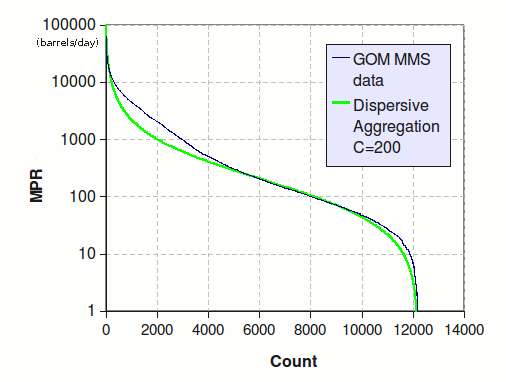GOM Maximum Production Rate and Macondo
I did some analysis based on Berman's post from a few days ago:
(Estimated Oil Flow Rates From the BP Mississippi Canyon Block 252 “Macondo” Well)
I think he messed up the statistics because of his use of a truncated data set from the MMS and the log-normal distribution he used.
I wasn't sure exactly how he got his data but I essentially had to screen scrape the data off of about 18 PDF files giving the Maximum Production Rate (MPR) going back to 1975: http://www.gomr.mms.gov/homepg/pubinfo/repcat/product/MPR.html
I plotted the results histogram against a model of dispersive aggregation for reservoir sizes. The maximum rate is then a simple proportional draw-down from the reservoir size. Bigger reservoirs have a higher rate and smaller reservoirs have a smaller rate -- nothing to argue about here as it is a pretty safe approximation. The way you read this histogram is that the flat regions have the highest frequency.

The integrated underneath the two curves is equal and about 16.5 million barrels per day peak. Don't confuse this with any rate attainable from the GOM; it is high because it sums up the peaks from a span of years. The median value is 200 barrels per day.
The interesting point in the curve is that the model predicts a higher peak rate for the largest reservoirs, the curve goes off the graph to above 400,000 barrels per day. Now, I would think that the operators would never try to have that throughput from a single well. So what do they do? Of course they split it into several wells to extract the maximum amount from that reservoir and essentially throttle that from an individual well.
Since the total amount is conserved between the two curves, the bulge that you see in the data is the extra wells drilled to make up for the excess. My model is totally based on the principle of Maximum Entropy applied to reservoir sizing, and the reordering of the rank histogram is caused by artificial constraints set by human intervention. Notice that all the small reservoirs effectively require no throttling.
The point of this comment is that working wells are likely throttled but the Macondo could conceivably be higher than the maximum of 50,000 barrels per day that Berman suggested. The operators have no way of throttling it until the relief wells are put in place. Of course this kind of throughput is very rare, as at the most a couple of dozen out of 10,000 reservoirs will get this big and generate this potential, but this is the way that nature operates, a big fat-tail effect.








